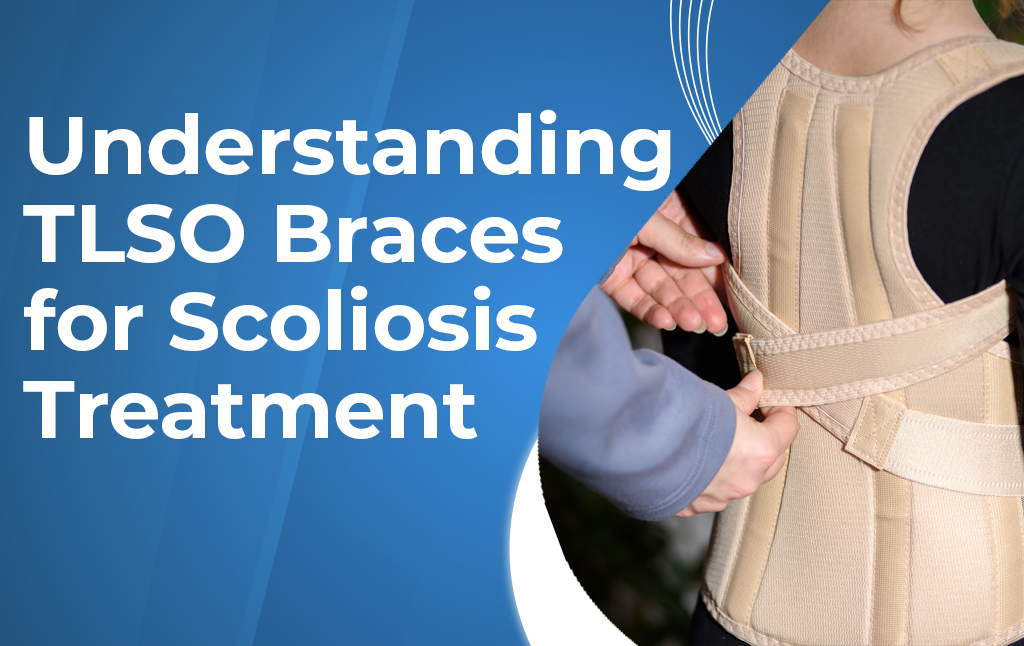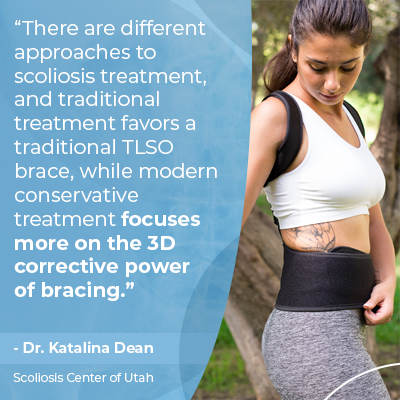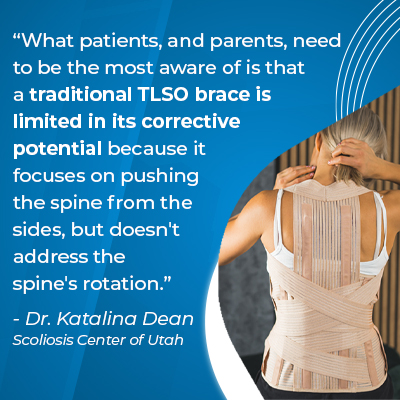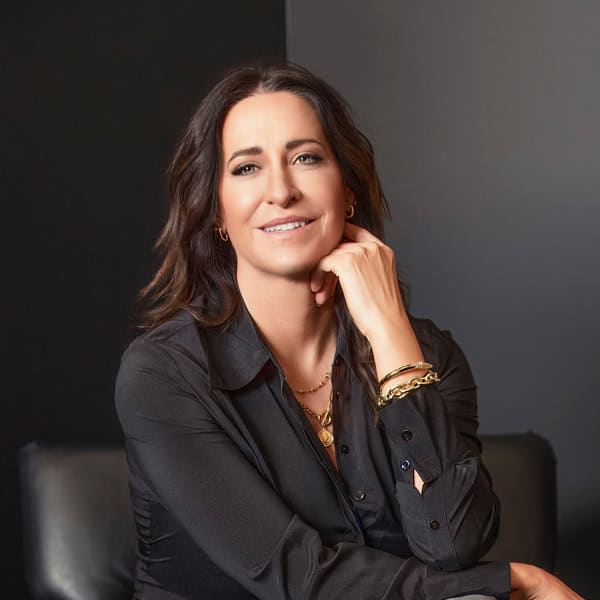Blogs
Understanding TLSO Braces for Scoliosis Treatment

There are different methods for treating scoliosis, and when it comes to nonsurgical conservative treatment options, bracing has shown impressive treatment results. It is important for patients to understand, however, that not all scoliosis braces offer the same potential results.
Scoliosis was first documented in ancient times, and while the concept of scoliosis bracing isn’t new, there has been a lot we’ve learned about scoliosis, and bracing efficacy, over the years. Traditional TLSO braces have shown success in treatment, but corrective 3-dimensional bracing has more to offer.
There is a lot of information about scoliosis treatment available, so it’s important that patients make informed treatment choices, including the type of scoliosis brace to commit to.
Bracing in Scoliosis Treatment
Scoliosis is a prevalent spinal condition that causes the development of an unnatural sideways-bending spinal curve that also rotates; scoliosis is 3-dimensional and needs to be treated as such.
For a unnatural spinal curve to develop, some of the spine’s vertebrae have become unnaturally tilted, and this means they are no longer aligned with the rest of the spine, and a spine that’s off balance and unstable can contribute to the body’s instability.
Bracing is one of the earliest forms of scoliosis treatment. A scoliosis brace is an orthotic device that fits snugly around the torso with the goal of straightening the scoliosis curve.
Bracing, however, has to work exactly as prescribed to be effective, and a significant challenge to bracing success is compliance.
While scoliosis affects all ages, it’s most often diagnosed during adolescence as adolescent idiopathic scoliosis, and this age group isn’t always compliant.
Full time bracing can mean up to 23 hours a day, and not all braces look and feel the same, so different rates of compliance is a factor.
Bracing can be used in the treatment of adult scoliosis, but this is more about stability and short-term pain relief than working towards significant corrections.
Growing spines are more malleable and respond better to bracing, which is why bracing is a regular facet of childhood scoliosis treatment.
 There are different approaches to scoliosis treatment, and traditional treatment favors a traditional TLSO brace, while modern conservative treatment focuses more on the 3D corrective power of bracing.
There are different approaches to scoliosis treatment, and traditional treatment favors a traditional TLSO brace, while modern conservative treatment focuses more on the 3D corrective power of bracing.
What is a TLSO Brace?
A TLSO brace is a thoracic lumbar sacral orthosis: a type of spinal brace that usually extends from the neck to the tailbone.
A TLSO brace is used to stabilize and immobilize the spine so can be used to address a number of spinal issues/conditions, including unnatural spinal curves.
So what type of results can a traditional TLSO brace offer? While no treatment results can ever be guaranteed, and there are a number of factors that shape how a patients responds to their brace, TLSO braces are associated with the following results:
A TLSO brace can provide an unstable spine with stability and support and help stop curves from progressing.
As scoliosis is progressive, a focus of treatment is on managing progression, and adolescents are the age group most at risk for rapid progression because it’s growth spurts that trigger progression.
Bracing is most often used in the treatment of adolescent idiopathic scoliosis because curves can progress rapidly, and when bracing is applied early, it’s shown success in counteracting progression and improving the spine’s alignment.
The most commonly used TLSO brace is the Boston brace, and while the Boston brace has shown positive results in some areas of scoliosis treatment, there are additional potential effects to consider.
Limitations of Traditional TLSO Braces
While there are a number of TLSO braces including the Charleston bending brace and the Providence brace and nighttime bracing, for our current purposes, and as it’s a common TLSO brace, let’s focus on the Boston brace.
The Boston brace was designed in the 1970s, and while brace design does include some individual measurements, it’s mass produced so can’t offer a fully custom fit.
In addition, the Boston is rigid and bulky and difficult to conceal under clothes; the biggest challenge to the Boston’s success is compliance.
Compliance monitors have to be in place, and are understandable as most young patients don’t want to stand apart from their friends. They don’t want to look different, walk differently, or be unable to participate in certain activities.
The Boston impacts the spine’s position through a 3-point pressure system that applies squeezing pressure to the spine, and while this can help straighten the spine, it can also weaken it over time, and a potential effective of spinal immobilization over long periods of time is weak muscles.
The spine’s surrounding muscles have to provide it with support and stability, so while a brace helping to straighten the spine is a positive outcome, the potential effect of a weak core should be considered.
In addition, the tight and rigid fit of the Boston is associated with skin irritation, breathing issues, and activity restrictions.
 What patients, and parents, need to be the most aware of is that a traditional TLSO brace is limited in its corrective potential because it focuses on pushing the spine from the sides, but doesn’t address the spine’s rotation.
What patients, and parents, need to be the most aware of is that a traditional TLSO brace is limited in its corrective potential because it focuses on pushing the spine from the sides, but doesn’t address the spine’s rotation.
So while the Boston brace can offer some positive potential outcomes, in terms of 3D correction, it’s limited, and in response, a modern innovative brace was designed that combines the positive potential outcomes of traditional bracing, while addressing some of its observed limitations.
Modern Corrective 3D Bracing: ScoliBrace
Modern corrective bracing has taken what we’ve learned about scoliosis and traditional bracing over the years, and clinicians have come up with what’s become known as the world’s most advanced scoliosis brace.
The ScoliBrace® addresses the limitations of traditional bracing in a number of different ways.
The ScoliBrace® uses the most advanced scanning technology and software to ensure that each brace offers a 100-percent custom fit for better compliance.
In addition, the ScoliBrace® is flexible and easily concealable under clothes. The brace can also be easily put on and removed at the front and further custom options include fabric color and pattern choice.
The ScoliBrace® works by pushing the spine, rather than applying pressure that can weaken the spine over time, and in addition, the more custom fit isn’t associated with skin irritation and breathing problems.
A significant difference between traditional and corrective bracing is the methodology: traditional bracing uses spinal immobilization while the ScoliBrace® was designed to allow for movement during wear time.
Allowing for movement helps maintain spinal flexibility and means the core and back muscles can stay strong and support the spine’s straighter alignment.
As the ScoliBrace® offers 3-dimensional correction, both the spine’s unnatural bend and twist may be addressed, and as the ScoliBrace® design doesn’t involve immobilization, when combined with the power of an individualized exercise-based physiotherapeutic program, there are more positive potential results to work towards.
Bracing and Exercise
So what’s important to understand about the difference between a traditional TLSO brace like the Boston and the modern ultra-corrective ScoliBrace® is that the potential results aren’t just isolated to the brace, but the treatment approach each brace is connected to.
Traditional scoliosis braces are part of a traditional treatment response that does little to prevent progression but commonly responds to severe cases with a surgical recommendation, but the reality is that many cases of scoliosis respond well to nonsurgical conservative treatment options that are less invasive and better for the spine’s long-term health.
Traditional treatment doesn’t include an exercise-based component, while it’s a focus of modern nonsurgical treatment.
ScoliBalance® combines the power of scoliosis-specific chiropractic care and exercise.
ScoliBalance® can help increase the spine’s strength, flexibility, correct curves, improve the spine’s balance, alignment, the spine’s surrounding muscle strength and balance, and can teach postural awareness.
Largely through the use of Mirror Image exercise, patients are taught how to hold their spine during movement to help counteract their curve and hold treatment results, and here at the Scoliosis Center of Utah, postural restoration is a priority.
Through chiropractic adjustments, core strengthening exercise, and postural restoration, the spine and body’s balance and stability can be improved for a better quality of life.
Conclusion
While early diagnosis is directly associated with treatment success, this involves a proactive treatment response.
When it comes to conservative treatment, a priority is on working towards preventing progression, rather than responding with treatment once a certain amount has already occurred.
While a traditional TLSO brace like the Boston brace has some potential positive results to offer in terms of slowing/stopping progression and realigning the spine, it also comes with some potential limitations and effects that need to be understood.
When it comes to modern corrective bracing like the ScoliBrace®, clinicians combined the best of what traditional bracing has to offer with an advanced understanding of spinal biomechanics and modern bracing efficacy.
And while no brace on its own can correct scoliosis, when combined with an innovative exercise-based program, there are fewer limits to what can be achieved.
Scoliosis patients need to understand the different treatment options available to them; following a scoliosis diagnosis, the most important decision is the type of treatment approach to commit to, and this includes the potential results a scoliosis brace has to offer.

Dr. Katalina Dean
Dr. Katalina Dean is the founder and clinical director of Scoliosis Center of Utah, in Midvale, UT. Her team specializes in posture correction, spinal rehabilitation, and non-invasive scoliosis care and bracing.
Call Today
Do You Qualify for Care?
Schedule an Appointment Below
